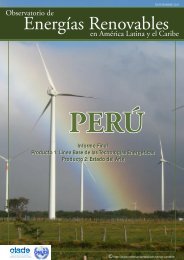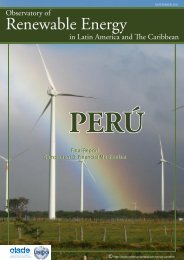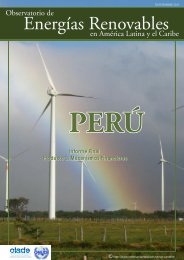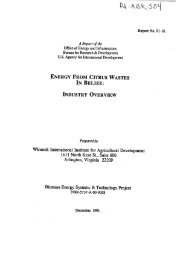PERÃ - Observatory for Renewable Energy in Latin America and
PERÃ - Observatory for Renewable Energy in Latin America and
PERÃ - Observatory for Renewable Energy in Latin America and
Create successful ePaper yourself
Turn your PDF publications into a flip-book with our unique Google optimized e-Paper software.
<br />
Perú- Products I <strong>and</strong> II<br />
<br />
1.3.11 Installed Capacity <strong>in</strong> the National Interconnected Electrical System<br />
In terms of <strong>in</strong>stalled capacity <strong>and</strong> electricity generation, the SEIN represents 97 %<br />
<strong>and</strong> 93 % of the Peruvian electricity market, respectively; with isolated systems<br />
cover<strong>in</strong>g the rest of the country. There<strong>for</strong>e to analyze the Peruvian electricity<br />
market it only would be necessary to mention the SEIN. The generation supply of<br />
the SEIN is set <strong>in</strong> terms of effective capacity, consider<strong>in</strong>g the last one as the<br />
nom<strong>in</strong>al power <strong>in</strong> MW of the generat<strong>in</strong>g groups which is “punished” by a factor<br />
that takes <strong>in</strong>to account the operat<strong>in</strong>g conditions of the location like the<br />
environmental temperature, the height above sea level where the station is<br />
located, among others. To March of 2011, the effective power of the SEIN was<br />
6 428 MW, of which 3 111 MW (48,4 %) correspond to renewable technologies<br />
<strong>and</strong> 3 328 MW (51,6 %) to non renewable technologies. In this case, 2 519 MW<br />
are generated by natural gas stations which represents 39,2 % of the total, as it is<br />
<strong>in</strong>dicated <strong>in</strong> Graphic Nº 13. In the low water period that shows up between May<br />
<strong>and</strong> October of every year, the available hydroelectric supply decreases <strong>in</strong> 22 %<br />
by the reduction <strong>in</strong> the water resource availability. (COES, 2010).<br />
Graphic N° 13: Effective Capacity <strong>in</strong> the SEIN (2011)<br />
1.3.12 Electricity Generation by Type of Technology at a National Level<br />
The electricity generation is pr<strong>in</strong>cipally hydrothermic, this means that the energy<br />
that covers the country’s dem<strong>and</strong> comes from the use of hydraulic power <strong>and</strong><br />
fossil fuels. From the last ones, natural gas is used <strong>in</strong> higher rates. (MEM, 2009b).<br />
In addition, there is a little fraction of the electric power that is generated from<br />
biomass (bagasse) which is less than 0,2 % of the total country’s production<br />
(MEM, 2011i) <strong>and</strong> is obta<strong>in</strong>ed of the productive processes of the sugar ref<strong>in</strong>eries.<br />
F<strong>in</strong>ally, <strong>in</strong> a smaller quantity, it is generated electricity with solar energy<br />
(photovoltaic panels), which implementation has taken place fundamentally to<br />
meet social commitments assumed by the State, with facilities dispersed through<br />
the whole country <strong>and</strong> whose <strong>in</strong>dividual capacity does not surpass the megavatio.<br />
Dur<strong>in</strong>g 2010, the total power generation <strong>in</strong> the electricity market was 35 736<br />
25









